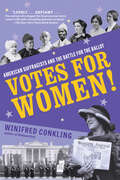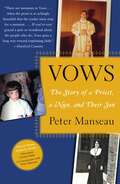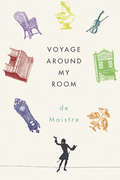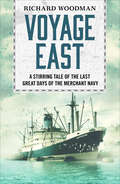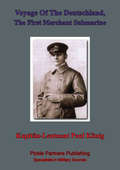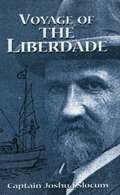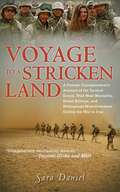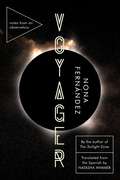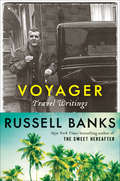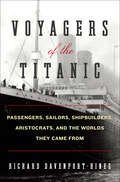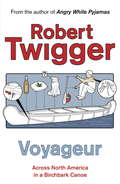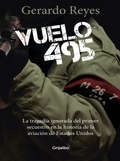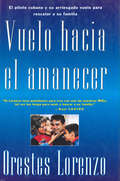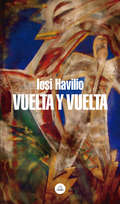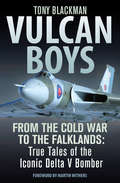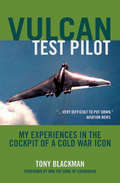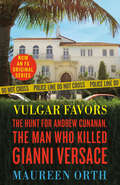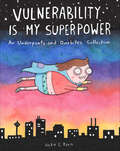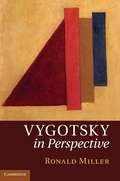- Table View
- List View
Votes for Women!: American Suffragists and the Battle for the Ballot
by Winifred ConklingFor nearly 150 years, American women did not have the right to vote. On August 18, 1920, they won that right, when the 19th Amendment to the Constitution was ratified at last. To achieve that victory, some of the fiercest, most passionate women in history marched, protested, and sometimes even broke the law—for more than eight decades. From Susan B. Anthony and Elizabeth Cady Stanton, who founded the suffrage movement at the 1848 Seneca Falls Convention, to Sojourner Truth and her famous “Ain’t I a Woman?” speech, to Alice Paul, arrested and force-fed in prison, this is the story of the American women’s suffrage movement and the private lives that fueled its leaders’ dedication. Votes for Women! explores suffragists’ often powerful, sometimes difficult relationship with the intersecting temperance and abolition campaigns, and includes an unflinching look at some of the uglier moments in women’s fight for the vote. By turns illuminating, harrowing, and empowering, Votes for Women! paints a vibrant picture of the women whose tireless battle still inspires political, human rights, and social justice activism.
Vous Buvez Quao?: L'Origine Du Nom Des Cocktails
by Jerry BaderVous Buvez Quao? L'Origine Du Nom Des Cocktails Publié par MRPwebmedia Pourquoi nomme-t-on les boissons à base d’alcool ‘cocktails’? D’où tirent-ils leur nom exotique: des noms comme Singapore Sling, Screwdriver, Alamagoozlum, Angel’s Kiss, Hanky Panky, Harvey Wallbanger, Sex On The Beach, Monkey Gland, Brass Monkey, Margarita, Japalac, Lion’s Tail, et bien d’autres encore ? Qui a trouvé leur nom, où ont-ils été inventés, pourquoi, et comment les réaliser? Les réponses à ces questions se trouvent dans Vous buvez quoi? un panorama à travers des faits, personnes et lieux qui entrent dans le processus de création de ces préparations exotiques.
Vows: The Story of a Priest, a Nun, and Their Son
by Peter ManseauThe 1950s was a boom time for the Catholic Church in America, with large families of devout members providing at least one son or daughter for a life of religious service. Boston was at the epicenter of this explosion, and Bill Manseau and Mary Doherty -- two eager young parishioners from different towns -- became part of a new breed of clergy, eschewing the comforts of homey parishes and choosing instead to minister to the inner-city poor. Peter Manseau's riveting evocation of his parents' parallel childhoods, their similar callings, their experiences in the seminary and convent, and how they met while tending to the homeless of Roxbury during the riot-prone 1960s is a page-turning meditation on the effect that love can have on profound faith. Once married, the Manseaus continued to fight for Father Bill's right to serve the church as a priest, and it was into this situation that Peter and his siblings were born and raised to be good Catholics while they witnessed their father's personal conflict with the church's hierarchy. A multigenerational tale of spirituality, Vows also charts Peter's own calling, one which he tried to deny even as he felt compelled to consider the monastic life, toying with the idea of continuing a family tradition that stretches back over 300 years of Irish and French Catholic priests and nuns. It is also in Peter's deft hands that we learn about a culture and a religion that has shaped so much of American life, affected generations of true believers, and withstood great turmoil. Vows is a compelling tale of one family's unshakable faith that to be called is to serve, however high the cost may be.
Voyage Around My Room
by Richard Howard Stephen Sartarelli Joseph De Maistre Xavier De MaistreA lively and utterly singular travelogue of the intricate curiosities that are directly within one’s own reach In 1790, while serving in the Piedmontese army, the French aristocrat Xavier de Maistre (1763–1852) was punished for dueling and placed under house arrest for forty-two days. The result was a discursive, mischievous memoir Voyage Around My Room, and its sequel, Nocturnal Expedition Around My Room. Admired by Nietzsche and Machado de Assis, Ossian and Susan Sontag, this classic book proves that sitting on the living-room sofa can be as fascinating as crossing the Alps or paddling up the Amazon. In addition to the Voyage and Expedition, this edition also includes the dialogue “The Leper of the City of Aosta,” a preface by Xavier’s better-known older brother (the royalist philosopher Joseph de Maistre), and an introduction by Richard Howard.
Voyage East
by Richard WoodmanA stirring tale of life aboard ship during the last great days of the Merchant NavyNew junior officer Laddie signs on to the cargo liner Antigone on a voyage to the Far East. He finds himself part of a crew who all have their own stories to tell about life at sea.Over the course of the eventful journey to Hong Kong and Singapore, he comes to know them all, from Captain ‘China Dick’ Richards and the experienced and remote Master to the vulnerable young radio officer Sparks and the deck crew.Little does Laddie know, but this voyage will be a turning point for Antigone and all who sail in her...Perfect for fans of Patrick O’Brian and Dewey Lambdin, Richard Woodman draws upon his six years of service on ships to evocatively capture life aboard.
Voyage Of The Deutschland, The First Merchant Submarine
by Kapitänleutnant Paul KönigThe arrival of the submarine Deutschland in the harbour of New York in July of 1916 produced one of the sensation of the year. How had a U-Boat sailed all the way from Germany to the United States evading all of the counter-measures of the might Royal Navy and the even the U.S. coastal defences? The captain of the Deutschland, Paul König, was feted as a national hero in Germany and was lauded by those of German extraction in New York.He wrote this memoir of his famed journey from the inland waters of Germany all the way to the United States, it is filled with the dangers of the nascent submarine, in particular the fumes and heat of the diving compartment. Notable also the U-Boat had come as a merchantman, meaning that König was unarmed for combat and could only rely on deception to fulfill his mission to outwit his enemies.Author -- Kapitänleutnant Paul König (1867-1933)Text taken, whole and complete, from the edition published in New York, Hearst's international library co., 1916.Original Page Count - xii and 247 pages.
Voyage of the Liberdade
by Joshua SlocumIn 1890, the author became the first person to circumnavigate the globe alone. This is the account of one of his lesser-known but no less remarkable sea journeys. From the Publisher: Great 19th-century mariner's thrilling, account of the wreck of his ship off the coast of South America, the 35-foot brave little craft he built from the wreckage, and its remarkable, danger-fraught voyage home. A 19th-century maritime classic brimming with courage, ingenuity, and daring. Easy-to-read and fast-paced.
Voyage to a Stricken Land: A Female Correspondent's Account of the Tactical Errors, Wild West Mentality, Brutal Killings, and Widespread Misinformation During the War in Iraq
by Sara DanielIn June of 2002, war looms and Saddam Hussein still has a brutal grip on a nation in disarray. Sara Daniel travels the length and breadth of Iraq, following the fast-evolving events and interviewing people from all walks of life and all religious and political affiliations: from the Kurds in the north to the rising new politicians in Baghdad and beyond; from the insurgents in Sadr City and Fallujah to the police chief in Basra; from the hospital doctors tending the maimed and wounded to the directors of museums whose collections were ruthlessly pillaged; from ordinary men and women in the streets to those vying to fill the void of power; from American soldiers on deadly street patrol to the highest-ranking officers. Voyage to a Stricken Land offers a cogent, personal history of one of America's most controversial conflicts.
Voyager: Constellations of Memory
by Nona FernándezA startling book-length essay, at once grand and intimate, from National Book Award finalist Nona Fernández.Voyager begins with Nona Fernández accompanying her elderly mother to the doctor to seek an explanation for her frequent falls and inability to remember what preceded them. As the author stares at the image of her mother’s brain scan, it occurs to her that the electrical signals shown on the screen resemble the night sky.Inspired by the mission of the Voyager spacecrafts, Fernández begins a process of observation and documentation. She describes a recent trip to the remote Atacama desert—one of the world’s best spots for astronomical observation—to join people who, like her, hope to dispel the mythologized history of Chile’s new democracy. Weaving together the story of her mother’s illness with story of her country and of the cosmos itself, Fernández braids astronomy and astrology, neuroscience and memory, family history and national history into this brief but intensely imagined autobiographical essay. Scrutinizing the mechanisms of personal, civic, and stellar memory, she insists on preserving the truth of what we’ve seen and experienced, and finding ways to recover what people and countries often prefer to forget.In Voyager, Fernández finds a new container for her profound and surreal reckonings with the past. One of the great chroniclers of our day, she has written a rich and resonant book.
Voyager: Travel Writings
by Russell BanksThe acclaimed, award-winning novelist takes us on some of his most memorable journeys in this revelatory collection of travel essays that spans the globe, from the Caribbean to Scotland to the HimalayasNow in his mid-seventies, Russell Banks has indulged his wanderlust for more than half a century. In this compelling anthology, he writes that since childhood he has "longed for escape, for rejuvenation, for wealth untold, for erotic and narcotic and sybaritic fresh starts, for high romance, mystery, and intrigue." The longing for escape has taken him from the "bright green islands and turquoise seas" of the Caribbean islands to peaks in the Himalayas, the Andes, and beyond. In Voyager, Russell Banks, a lifelong explorer, shares highlights from his travels: interviewing Fidel Castro in Cuba; motoring to a hippie reunion with college friends in Chapel Hill, North Carolina; eloping to Edinburgh to marry his fourth wife, Chase; driving a sunset-orange metallic Hummer down Alaska's Seward Highway. In each of these remarkable essays, Banks considers his life and the world. In Everglades National Park, he traces his own timeline: "I keep going back, and with increasing clarity I see more of the place and more of my past selves. And more of the past of the planet as well." Recalling his trips to the Caribbean in the title essay, "Voyager," Banks dissects his relationships with the four women who would become his wives. In the Himalayas, he embarks on a different quest of self-discovery. "One climbs a mountain, not to conquer it, but to be lifted like this away from the earth up into the sky," he explains. Pensive, frank, beautiful, and engaging, Voyager brings together the social, the personal, and the historical, opening a path into the heart and soul of this revered writer."If the United States were to adopt Japan's admirable policy of designating a few extraordinary individuals as Living National Treasures, Russell Banks would be my first nomination."--Michael Cunningham"Russell Banks is a writer in the grand tradition. It is quite natural, in speaking of Banks's great works of fiction, to think of such predecessors as Conrad, Tolstoy, and Chekhov--and closer to his American home, such predecessors as Jack London, Theodore Dreiser, Hemingway, Dos Passos, Faulkner, and Nelson Algren. He has acquired an international reputation for the intensely wrought, uncompromising, and intransigent moral vision that has suffused virtually all of his work. He has created art of a kind that speaks to all classes, not merely to the elite, and yet has done so scrupulously and thoughtfully."--Joyce Carol Oates
Voyagers of the Titanic: Passengers, Sailors, Shipbuilders, Aristocrats, and the Worlds They Came From
by Richard Davenport-Hines“The story of the Titanic has been told many times; this one takes a sociological perspective, with the confident, graceful prose of fine fiction.” —Wall Street JournalIt has been over one hundred years since the sinking of the passenger liner Titanic in the North Atlantic, yet worldwide fascination with the epic tragedy remains as strong as ever. With Voyagers of the Titanic, Richard Davenport-Hines gives us a magnificent history of the people intimately connected with the infamous ship—from deal-makers and industry giants, like J.P. Morgan, who built and operated it; to Molly Brown, John Jacob Astor IV, and other glittering aristocrats who occupied its first class cabins; to the men and women traveling below decks hoping to find a better life in America. Voyagers of the Titanic offers a fascinating, uniquely original view of one of the most momentous catastrophes of the twentieth century.“Impressive in both its writing and reporting.” —USA Today“Eloquent and absorbing.” —The Telegraph (UK))“This will not be the last book on the Titanic, but it is a safe bet that there will not be a better.” —The Spectator (UK)“Bolstered by photographs of the people who built, staffed, sailed on and survived the Titanic, Davenport-Hines finds a slew of new points of view from which to scan history.” —Denver Post“Utterly compelling.” —Sunday Times (UK)“Paints a provocative portrait of the “upstairs, downstairs” social stratification in play aboard the doomed ship.” —Entertainment Weekly“An astonishing work.” —Julian Fellowes, Creator and Executive Producer of Downton Abbey“A haunting story of real, intersecting lives on a collision course with destiny.” —Kirkus Reviews
Voyageur: Across the Rocky Mountains in a Birchbark Canoe
by Robert TwiggerBest-selling author of Angry White Pyjamas travels across the Rocky Mountains by canoeFifteen years before Lewis and Clark, Scotsman Alexander Mackenzie, looking to open up a trade route, set out from Lake Athabasca in central Northern Canada in search of the Pacific Ocean. Mackenzie travelled by bark canoe and had a cache of rum and a crew of Canadian voyageurs, hard-living backwoodsmen, for company. Two centuries later, Robert Twigger decides to follow in Mackenzie's wake. He too travels the traditional way, having painstakingly built a canoe from birchbark sewn together with pine roots, and assembled a crew made up of fellow travelers, ex-tree-planters and a former sailor from the US Navy. Several had tried before them but they were the first people to successfully complete Mackenzie's diabolical route over the Rockies in a birchbark canoe since 1793. Their journey takes them to the remotest parts of the wilderness, through Native American reservations, over mountains, through rapids and across lakes, meeting descendants of Mackenzie and unhinged Canadian trappers, running out of food, getting lost and miraculously found again, disfigured for life (the ex-sailor loses his thumb), bears brown and black, docile and grizzly.
Voyageur: Across the Rocky Mountains in a Birchbark Canoe
by Robert TwiggerBest-selling author of Angry White Pyjamas travels across the Rocky Mountains by canoeFifteen years before Lewis and Clark, Scotsman Alexander Mackenzie, looking to open up a trade route, set out from Lake Athabasca in central Northern Canada in search of the Pacific Ocean. Mackenzie travelled by bark canoe and had a cache of rum and a crew of Canadian voyageurs, hard-living backwoodsmen, for company. Two centuries later, Robert Twigger decides to follow in Mackenzie's wake. He too travels the traditional way, having painstakingly built a canoe from birchbark sewn together with pine roots, and assembled a crew made up of fellow travelers, ex-tree-planters and a former sailor from the US Navy. Several had tried before them but they were the first people to successfully complete Mackenzie's diabolical route over the Rockies in a birchbark canoe since 1793. Their journey takes them to the remotest parts of the wilderness, through Native American reservations, over mountains, through rapids and across lakes, meeting descendants of Mackenzie and unhinged Canadian trappers, running out of food, getting lost and miraculously found again, disfigured for life (the ex-sailor loses his thumb), bears brown and black, docile and grizzly.
Voz que escondi
by Carolina JadueRelato en primera persona de la noche en que El Tila, conocido como El psicópata de La Dehesa, atacó a una familia completa. Carolina Jadue sobrevivió a esa noche y al trauma que vino después. Hace veinte años, la familia Jadue Zaror vivó una pesadilla. La noche del 5 de junio de 2002, su departamento en Camino El Huinganal, La Dehesa, fue asaltado por Roberto Martínez Vásquez, un delincuente de 26 años conocido como El Tila. Tras años de residencia en el Sename, El Tila asoló Santiago ese año con una seguidilla de asaltos, violaciones y asesinatos. Carolina Jadue tenía 19 años cuando se convirtió en su víctima. Estuvo al borde de la muerte y en este libro describe, con crudeza y valentía, los pormenores de esa noche, el trauma posterior y el trabajo terapéutico que ha hecho desde entonces.
Vozes Divinas e Demoníacas. Vida e Morte de Joana D'Arc.
by Borja Loma Barrie Luiza Castilho Saturnino BragaRomance histórico. Biografia. A morte na fogueira de Joana D'Arc. Vida de Joana D'Arc. História da França. História da Guerra dos Cem Anos. Carrascos da época. Como executavam as bruxas.
Vrajanatha Vadajena
by Janaki Ballabha MohantyOn the life and works of Oriya Poet Vrajanatha Vadajena.
Vuelo 495
by Gerardo ReyesEl vuelo 495 de Cubana de Aviación salió de Miami a Varadero el primero de noviembre de 1958 y nunca llegó a su destino en Cuba. A menos de dos meses del triunfo de la revolución, cinco jóvenes secuestraron el avión a nombre del 26 de Julio, el movimiento que lideraba el comandante guerrillero Fidel Castro. Llevaban armas, municiones y posiblemente dinero. Fue el primer acto de piratería aérea en la historia de Estados Unidos, con un agravante: la operación terminó en una tragedia en la que perdieron la vida más de la mitad de los pasajeros. Este siniestro quedó en el olvido y la absoluta impunidad. Sin embargo, durante más de diez años el periodista colombiano Gerardo Reyes Copello, co-ganador del Premio Pulitzer, se ha dedicado a esclarecer los hechos. Recaudó una gran cantidad de información del accidente y del fascinante contexto histórico en el que ocurrió. Habló con sobrevivientes que relataron el drama a bordo del avión y con testigos que lo vieron caer; descubrió documentos secretos inéditos y logró confrontar a uno de los sospechosos del secuestro. La historia tiene como epicentro el mundo conspirativo de Miami, una ciudad donde los sótanos de la memoria de muchos de sus habitantes están llenos de guerras clandestinas y complots que relatan abiertamente como si el tiempo lo perdonara todo. A lo largo del libro se presentan los elementos para entender la conspiración de silencio y desdén que borró de la historia el siniestro durante más de cincuenta años. Fidel aseguró que no habían autorizado la operación y su hermano Raúl anunció que llevaría al paredón a los responsables. Los lectores podrán enterarse del giro que dio el ultimátum en las páginas de esta obra periodística. English Description Cubana de Aviación’s flight 495 left Miami for Varadero on November 1, 1958, and never arrived at its destination in Cuba. Less than two months shy of the Cuban revolution, five young people hijacked the plane in the name of the 26th of July Movement, which was led by guerrilla commander Fidel Castro. They carried weapons, ammunition, and possibly money. It was the first act of air hijacking in the history of the United States, and with an additional problem: the operation ended in a tragedy that killed more than half of the passengers aboard. This disaster went forgotten and absolutely unpunished. Nevertheless, for more than ten years, Colombian journalist and Pulitzer Prize cowinner Gerardo Reyes Copello has dedicated himself to uncovering the facts.
Vuelo hacia el amanecer: El Vuelo De Orestes Lorenzo
by Orestes LorenzoEn 1991, Orestes Lorenzo, un mayor en la Fuerza Aérea Cubana, desertó su país de origine en un avión MiG y arriesgó todo lo que tenia para realizar un peligroso vuelo a los Estados Unidos buscando la libertad ideológica que ya no existía en Cuba. Pero fue en 1992, un año más tarde cuando Orestes realizó un viaje aun más peligroso. Después de 21 meses frustrantes, haciendo peticiones a las autoridades cubanas, pidiendo la libertad de su familia, Orestes se dio cuenta de una cosa: la única solución tendría que ser algo sumamente arriesgado y difícil. Habría que volver a Cuba a buscarlos él mismo. Durante todo este tiempo, su esposa Vicky sufrió el constante asedio de las autoridades cubanas, que insistieron que denunciara a su esposo como un cobarde traidor que abandonó a su familia. De lo contrario, jamás tendría permiso para salir de su país. Hasta Raúl Castro, hermano del dictador, tenía algo que decir sobre el asunto: -Si Lorenzo tuvo pantalones para irse con uno de nuestros MiGs, tal vez los tenga para venir a buscar a su familia.- Y eso fue lo que Orestes Lorenzo hizo. Volando un viejo Cessna de dos motores, cruzó las aguas del estrecho de la Florida, evitando el radar cubano. Aterrizó en una carretera bien transitada donde su esposa y sus hijos le esperaban, y les rescató. Vuelo hacia el amanecer es la historia de esta hazaña asombrosa, narrada por el mismo protagonista, Orestes Lorenzo. Es también la odisea individual de un joven que creció durante la euforia de la revolución cubana. Después de casarse y entra en un entrenamiento para pilotos en la unión soviética, Orestes nos muestra su creciente desilusionamiento con el comunismo, apoyado por su despertar a la religión gracias a las revelaciones de la Perestroika y la enfermedad grave de su esposa. Sobre todo, sus motivos tienen sus raíces en la convicción de criar a sus hijos en un país que respeta la dignidad del espíritu individual. Vuelo hacia el amanecer es una historia de heroísmo, el heroísmo de un hombre que haría lo imposible y arriesgaría su vida para obtener la libertad de su familia. Es un testamento al poder y fuerza del amor.
Vuelta y vuelta
by Iosi HavilioEl nuevo libro de Iosi Havilio, autor de Opendoor y Pequeña flor, entre otras celebradas novelas, es una historia alucinada sobre el duelo, tras la muerte de una madre. La nueva novela de Iosi Havilio es una historia sobre la búsqueda de sentido y también es una fábula realista. En medio del duelo por la muerte de su madre, una mujer muy especial cuya huella ha quedado marcada en sus hijos y en su arte, el autor y protagonista de esta ficción se embarca en una aventura extrema, que se inicia en la isla Martín García y lo llevará a conocer personas extraordinarias en un viaje tan alucinado como consciente. Con un trabajo singularísimo del lenguaje, aboliendo las normas, la narración se vuelve hipnótica y logra una atracción irreversible hacia su genial universo literario.
Vulcan Boys: From the Cold War to the Falklands: True Tales of the Iconic Delta V Bomber (The\jet Age Ser. #6)
by Tony BlackmanAn in-depth look at these Cold War–era bombers, in the words of those who flew them—includes photos. The Vulcan, the second of the three V bombers built to guard the United Kingdom during the Cold War, has become an aviation icon like the Spitfire, its delta shape as instantly recognizable as the howling noise it makes when the engines are opened for takeoff. Vulcan Boys is the first book about this bomber recounted completely firsthand by the operators themselves. It tells the story of the aircraft from its design conception through the Cold War, when it played out its most important job as Britain&’s nuclear deterrent; it also reveals the significant role its bombs and missiles played in liberating the Falkland Islands, for which it gained much celebrity. These individual accounts detail how hours at a time were spent waiting to be scrambled to defend the country in the event of a third world war, and how pilots&’ aggressive skills were honed by carrying out Lone Ranger sorties flying to the United States and westward around the world, and taking part in Giant Voice and Red Flag, competitive exercises against the US Strategic Air Command. The attacks in the Falklands using Shrike missiles are described accurately and in great detail for the first time, including the landing at Rio de Janeiro alongside a vivid account of Black Buck 2. Vulcan Boys is a fascinating and completely authentic read reminding us of the Cold War, how it was fought, and the considerable effort required to prevent all-out nuclear war.
Vulcan Test Pilot: My Experiences in the Cockpit of a Cold War Icon
by Tony BlackmanIn this memoir, the author of Nimrod: Rise and Fall details his experience testing the UK&’s strategic bomber while flying for Avro during the Cold War. In 2007, a restored Avro Vulcan Mark 2—XH558—took to the skies to help commemorate the 25th anniversary of the Falklands conflict. To coincide with this, the memoirs of one of its test pilots, Tony Blackman, was published to great acclaim. Tony flew no less than 105 of the 136 built, logging 850 flights at over 1,327 hours. His book describes in layman&’s terms what it was like to tame the first prototypes of the monumental delta-wing aircraft and to master the unusual characteristics necessitated by the Vulcan&’s shape. Although Tony puts the developments, demonstrations, incidents, and accidents in their political and historical context, his story is a highly personal one. He explains how this awesome aircraft became a national treasure and captured the imagination of the whole country. His words, descriptions, and photographs will make people feel as he did the excitement of handling such an incredibly powerful monster always in the knowledge that he had to be always in complete control of the monster as it could, and did, bite back.Praise for Vulcan Test Pilot&“Highly readable, keeping both the technical reader interested without perplexing the layman. A fine book for both.&” —Logbook &“Fascinating, gracefully written, and superbly knowledgeable.&” —Air and Space Magazine
Vulgar Favors (FX American Crime Story Tie-in Edition): The Assassination of Gianni Versace
by Maureen OrthThe basis for the FX true crime series American Crime Story: The Assassination of Gianni Versace, from creator Ryan Murphy and starring Edgar Ramirez, Penelope Cruz, Darren Criss, and Ricky MartinTwo months before Gianni Versace was murdered on the steps of his Miami Beach mansion by Andrew Cunanan, award-winning journalist Maureen Orth was investigating a major story on the serial killer for Vanity Fair. Culled from interviews with more than four hundred people and insights from thousands of pages of police reports, Orth tells the complete story of Cunanan, his unwitting victims, and the moneyed, hedonistic world in which they lived . . . and died. In fascinating detail, she reveals how Cunanan met his superstar victim, why police and the FBI repeatedly failed to catch Cunanan, and why other victims’ families stonewalled the investigation, as well as the controversial findings of the Versace autopsy report. Here is a gripping odyssey that races across America—from California’s wealthy gay underworld to modest Midwestern homes of families mourning the loss of their sons to South Beach and its unapologetic decadence. Vulgar Favors is at once a masterwork of investigative journalism and a riveting account of a sociopath, his crimes, and the mysteries he left along the way.Praise for Vulgar Favors “[An] exhaustive deconstruction of Andrew Cunanan’s five murders . . . The breadth and thoroughness of Orth’s research are often staggering.”—The New York Times “Fascinating . . . ripe with chilling detail . . . paints a disturbing picture.”—Entertainment Weekly“A fascinatingly detailed account.”—USA Today “It will hook you from the first page and never let you go.”—San Francisco Chronicle “Vulgar Favors by Maureen Orth might be called the complete Cunanan. . . . She [has] an indefatigable hunger to know everything.”—Chicago Tribune “A detailed page-turner.”—St. Paul Pioneer Press “An exceptionally good account of suspected serial killer Andrew Cunanan’s spree in 1997 . . . Orth tells this twisted story with grace and courage.”—Fort Worth Star-Telegram “Orth has an inviting, readable style.”—Oakland Tribune “The definitive book on the July 15, 1997 murder of Versace.”—Sun-Sentinel “An exhilarating journalistic chronicle of Cunanan’s crime and flight . . . The book is charged with adrenaline and the pages just seem to turn themselves.”—Lesbian and Gay New York
Vulnerability Is My Superpower: An Underpants And Overbites Collection (Underpants and Overbites Collection)
by Jackie E. DavisVulnerability Is My Superpower features Jackie Davis's relatable diary comics about self-discovery, mental health, relationships, and childhood. From bouts with anxiety and insecurity to the thrill of simple pleasures like secretly trying on other people&’s coats at a party, she&’s figuring things out as she goes along, navigating domestic life with her husband, Pat (aka &“the Purple Guy&”), and sharing her most embarrassing thoughts and habits so you don&’t have to.For anyone who struggles with self-confidence or just likes to scrutinize the curious workings of relationships and everyday life, the confessional comic gems in this book invite laughter at even the most awkward and vulnerable moments while making you feel less alone.
Vygotsky in Perspective
by Ronald MillerLev Vygotsky has acquired the status of one of the grand masters in psychology. Following the English translation and publication of his Collected Works there has been a new wave of interest in Vygotsky, accompanied by a burgeoning of secondary literature. Ronald Miller argues that Vygotsky is increasingly being 'read' and understood through secondary sources and that scholars have claimed Vygotsky as the foundational figure for their own theories, eliminating his most distinctive contributions and distorting his theories. Miller peels away the accumulated layers of commentary to provide a clearer understanding of how Vygotsky built and developed his arguments. In an in-depth analysis of the last three chapters of Vygotsky's book Thinking and Speech, Miller provides a critical interpretation of the core theoretical concepts that constitute Vygotsky's cultural-historical theory, including the development of concepts, mediation, the zone of proximal development, conscious awareness, inner speech, word meaning and consciousness.
